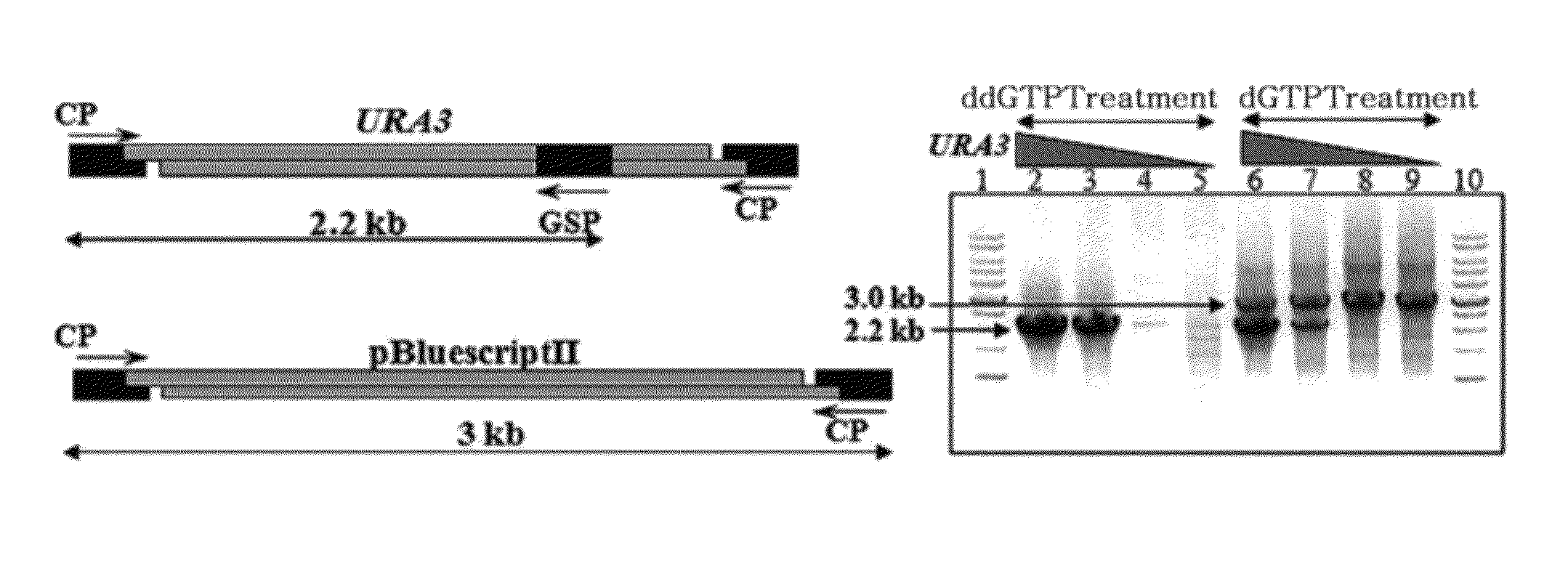Genome walking method for cloning of unknown DNA sequences adjacent to known sequences
a dna sequence and gene walking technology, applied in the field of gene walking methods, can solve the problems of low amplification efficiency, non-specific amplification, and large manpower and time required during the screening process, and achieve the effect of minimizing non-specific amplification and maximizing the ligation efficiency of the cass
- Summary
- Abstract
- Description
- Claims
- Application Information
AI Technical Summary
Benefits of technology
Problems solved by technology
Method used
Image
Examples
example 1
Cassette Construction
[0073]To examine and confirm the method of the present invention, a double-stranded cassette was first constructed. In order to ligate with genomic DNA which was digested with BamHI, BglII or Sau3A and had one base filled-in with ddGTP, a CSF primer of SEQ ID NO. 1 (GACGCGTAATACGACTCACTATAGGGA) and a CSR primer of SEQ ID NO. 2 (ATCTCCCTATAGTGAGTCGTATTACGCGTC) were synthesized. 40 μl of 100 μM CSF primer and 100 μM CSR primer were mixed with each other, and then 250 mM Tris.Cl (pH 8.0), 10 μl of 100 mM MgCl2 buffer, and 10 μl of distilled water were added, followed by heating in a water bath at 95° C. for 5 min. The water bath was left to cool to room temperature. The cassette constructed by this method had one blunt end and a protruding ATC sequences at its 5′-end.
example 2
Test on Genome Walking Method Using the Known Genes
[0074]Prior to application of the method of the present invention to the experiment of cloning a specific region from genomic DNA, the method was tested using a plasmid and a gene, of which base sequence has been known. As shown in FIG. 3, 2.5 kb of BamHI-restriction fragment containing the URA3 gene and 3 kb of BamHI-restricted pBluescriptII plasmid were used to examine the effect of terminal modification with ddGTP.
[0075]0.5 μg of BamHI-restricted pBluescriptII plasmid used as a non-specific DNA and 10 ng, 1 ng, 0.1 ng, and 0.01 ng of URA3 BamHI fragment used as a target gene were mixed, respectively. 1 μl of 2 mM ddGTP and 2 μl of 10× Klenow fragment buffer solution [100 mM Tris.Cl (pH7.5), 70 mM MgCl2, 1 mM DTT] were added, and then distilled water was added to a final volume of 20 μl. Subsequently, 5 units of Klenow fragment (Takara) were added, and reacted at 37° C. for 30 min. For comparison, dGTP was used instead of ddGTP to...
example 3
Cellulase Gene Cloning Using Genome Walking Method
[0077]In order to clone a novel cellulase gene, the present inventors selected the fungus having cellulase activity, and identified by sequence analysis a 26 S ribosomal RNA gene, resulting in the identification of a Penicillium sp. cf4 strain belonging to the genus Penicillium. Based on the cloned cellulase gene sequence, 11 pairs of degenerate primers were designed in order to clone a cellulase gene from the strain. The genomic DNA of the strain was subjected to PCR, and 0.4-kb and 0.45-kb PCR products containing a part of cellulase gene were obtained. Each PCR product was cloned into a pGEM-T Easy vector (Invitrogen), followed by sequence analysis. As a result, both of the PCR products were a part of the exo-glucanase gene, and identical sequences have not been discovered in any genes reported to date. Thus, since there was a high probability that the cellulase gene is a novel gene, a genome cassette library was constructed using ...
PUM
| Property | Measurement | Unit |
|---|---|---|
| temperature | aaaaa | aaaaa |
| volume | aaaaa | aaaaa |
| volume | aaaaa | aaaaa |
Abstract
Description
Claims
Application Information
 Login to View More
Login to View More - R&D
- Intellectual Property
- Life Sciences
- Materials
- Tech Scout
- Unparalleled Data Quality
- Higher Quality Content
- 60% Fewer Hallucinations
Browse by: Latest US Patents, China's latest patents, Technical Efficacy Thesaurus, Application Domain, Technology Topic, Popular Technical Reports.
© 2025 PatSnap. All rights reserved.Legal|Privacy policy|Modern Slavery Act Transparency Statement|Sitemap|About US| Contact US: help@patsnap.com



